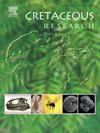First record of a lungfish (Sarcopterygii: Dipnoi) in the Upper Cretaceous of the Chubut Group, Golfo San Jorge Basin, Argentina. paleoenvironmental and paleoclimatic considerations
IF 1.7
3区 地球科学
Q1 GEOLOGY
引用次数: 0
Abstract
Here, we describe a tooth plate (UNPSJB-PV 1047), from fluvial sandstones of the “middle section” of the Lago Colhué Huapi Formation exposed in the locality of “Playa Kruger” (Santonian?–lower Maastrichtian?), central Patagonia, Argentina. This a prearticular plate that has been assigned to the genus Metaceratodus and provisionally to the species Metaceratodus kaopen. Shared features include the presence of a lingual edge that tends to be straight and a medial edge that is slightly curved, a long first denticulation with a broad base and no deep wear facets, and an end of the first denticulation without the formation of sinuosities. However, this interpretation is not definitive given the morphological variation of tooth plates within the same species. UNPSJB-PV 1047 represents the first record of these lungfish in the Golfo San Jorge Basin, expanding the geographic distribution of this taxon in South America and contributing to interpretations of its living environment. Its presence increases biodiversity for the Lago Colhué Huapi Formation and supports interpretations of the sedimentary paleoenvironment in the “middle section” of the Lago Colhué Huapi Formation, characterized by fluvial systems that seasonally interrupted their discharge under a warm climate with dry periods, suggesting an optimal environment for the development of lungfish.
阿根廷圣豪尔赫海湾Chubut群上白垩世首次记录到肺鱼(Sarcopterygii: Dipnoi)。古环境和古气候考虑
在这里,我们描述了一个齿板(UNPSJB-PV 1047),它来自于暴露在“Playa Kruger”(圣东统?-下马斯特里赫特?),巴塔哥尼亚中部,阿根廷。这是一个特殊的板块,被分配到Metaceratodus属,暂时属于Metaceratodus kaopen种。共同的特征包括舌缘趋于直,中缘略弯曲,第一齿长,基部宽,无深磨损面,第一齿的末端没有形成波纹。然而,考虑到同一物种中牙板的形态差异,这种解释并不确定。UNPSJB-PV 1047代表了这些肺鱼在圣乔治湾盆地的首次记录,扩大了该分类群在南美洲的地理分布,并有助于解释其生活环境。它的存在增加了Lago colhu华皮组的生物多样性,并支持了对Lago colhu华皮组“中段”沉积古环境的解释,其特征是河流系统在温暖的气候和干燥的时期季节性地中断其排放,表明肺鱼发育的最佳环境。
本文章由计算机程序翻译,如有差异,请以英文原文为准。
求助全文
约1分钟内获得全文
求助全文
来源期刊

Cretaceous Research
地学-地质学
CiteScore
4.10
自引率
19.00%
发文量
235
审稿时长
12 weeks
期刊介绍:
Cretaceous Research provides a forum for the rapid publication of research on all aspects of the Cretaceous Period, including its boundaries with the Jurassic and Palaeogene. Authoritative papers reporting detailed investigations of Cretaceous stratigraphy and palaeontology, studies of regional geology, and reviews of recently published books are complemented by short communications of significant new findings.
Papers submitted to Cretaceous Research should place the research in a broad context, with emphasis placed towards our better understanding of the Cretaceous, that are therefore of interest to the diverse, international readership of the journal. Full length papers that focus solely on a local theme or area will not be accepted for publication; authors of short communications are encouraged to discuss how their findings are of relevance to the Cretaceous on a broad scale.
Research Areas include:
• Regional geology
• Stratigraphy and palaeontology
• Palaeobiology
• Palaeobiogeography
• Palaeoceanography
• Palaeoclimatology
• Evolutionary Palaeoecology
• Geochronology
• Global events.
 求助内容:
求助内容: 应助结果提醒方式:
应助结果提醒方式:


